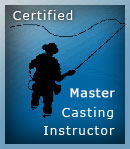Tarpon Fly Leaders
My first experience with Tarpon fly fishing was about fifteen years ago when I was invited to the Keys with a friend who provided our gear. We fished five days, two with a guide, and three on our own in my buddy’s new flats boat. The guided trips were especially helpful to us because it gave us a wealth of information about finding fish at different tides and was very close to where we stayed. The first time a giant tarpon follows your fly and opens his bucket-sized mouth to engulf your offering is a feeling that is overwhelming. Helplessness, fear, excitement, and disbelief are only a few of the emotions that will cause your whole body to shake. Everything that you heard or read preparing you for that moment will be a giant blur! If by some miracle, you set the hook and get line on the reel as he begins to empty your spool, you are on your way to one of the greatest thrills in fly fishing. What you don’t need is to have your leader or its components fail. This is exactly what happened to me, not once, but six times during that trip. I was not a happy camper! All the dreams and anticipation were short lived as the connection between the fly and my fly line separated and this silver giant left me feeling dejected. Names like Albright, Huffnagle, Bimini Twist, Surgeons, Class and Shock tippet began to haunt me.
Should you just buy some prepared Tarpon leaders and think you are now equipped to tackle the Silver King, or is it necessary to learn a new language and knot-tying technique? If saltwater fly fishing is something you want to become a larger part of your fishing future, bite the bullet and start to study and practice. The principles of leader design will be one of the important keys to success.
Using a “loop to loop” system in leader design will make some of the mystery disappear. Most guides are using fluorocarbon components because of its abrasion resistance and invisibility in the water. It will be expensive! However, once you have the material, you can make a lot of custom leaders. Before fluorocarbon, Ande monofilament with a Mason shock tippet accounted for a lot of tarpon.
For large fish, take some sixty pound test and make a surgeons loop at each end. The finished Butt section should be six feet in length. The loop at the fly end should be large enough to allow you to easily change flies without a lot of fumbling. Your flies will be attached to the shock tippet with either a loop type knot or snelled to the hook shank without using the eye. A class tippet will join the shock tippet to the butt section.
To prepare the class tippet, select enough material to make a Bimini twist at each end, leaving about eighteen inches of material between the finished knots. Twelve, to twenty pound test is frequently used for this application. One loop of the Bimini will be made into a double Surgeon’s loop. This is what will join the loop in the butt section. The other Bimini loop will be used to tie a Huffnagle, or Albright knot to your Shock tippet, which for large fish could be sixty to eighty pound test. After the fly is connected, the Shocker should be twelve inches or less. If you choice is to pursue “Baby Tarpon,” scale everything down accordingly. Forty pound Butt and Shock tippets can be used. The flies, attached to the tippets, should be stored in a stretcher box so that they are ready for immediate use.
This would be a good time to mention that your fly reel backing should be thirty pound test. The Class tippet should always test less than your backing so that you don’t send your new fly line along with the tarpon back to the Keys.
A description of how to tie these knots can be found in Mark Sosin and Lefty Kreh’s book “Practical Fishing Knots.” There are also fly fishing websites that have the above information. This system of leader design is good for any large saltwater species that have an abrasive mouth, such as snook.
Mastering leader and knot construction will be necessary to get the most out of your salt- water fly fishing experience. Like fly tying or rod building, another challenge awaits you on your continuous pursuit of conquering the Silver King.
![]()



